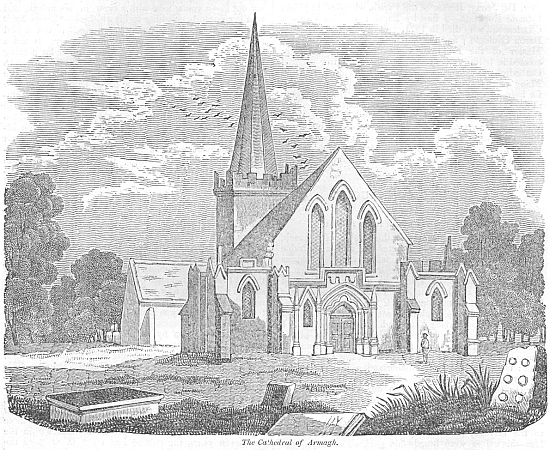The Cathedral Church of Armagh.
From The Dublin Penny Journal, Volume 1, Number 24, December 8, 1832.

The subject of our prefixed illustration can hardly fail of being interesting to our readers of every religious denomination, for though in itself of no great antiquity or architectural interest, it is intimately associated in our minds with the establishment of the Christian Faith in our Island, and with the mild but persevering labours of our Patron Saint. In the minds of the Milesian Irish it must awaken sentiments of just pride and recollections of national glory, for Armagh was a chief seat of religion and literature, a blazing star, when most other parts of the western world were involved in the darkness of idolatry and ignorance--and in the minds of the English, or Irish of English descent, it should excite sentiments of gratitude and affection for our country, for it was to this seminary of education that England was in a great degree indebted for the rudiments of learning, which have ultimately exalted her to such a pitch of glory. To the school which was founded here by St. Patrick, as we are informed by the Venerable Bede, multitudes of the English nobility and middle ranks resorted, and were supplied with books and food, and every other want, without charge, and in the most hospitable spirit.
The general history of Armagh would require a volume, and has been made the subject of a highly valuable and interesting one by Dr. Stewart, of Belfast. The nature of our little work, however, will only permit us to give it in distinct portions, and we shall, on the present occasion, confine ourselves to that of the subject of our illustration --its Cathedral Church.
The original edifice was erected by St. Patrick in the year 445. It appears from the authority of the tripartite life of the founder, to have been an oblong structure 140 feet in length, and divided into nave and choir, according to the custom of all our ancient Churches. This sacred edifice did not escape the sacrilegious devastations of the Northern Pirates. It was pillaged and burned, together with the other buildings of the City, in 839 and 850. In 890 it was partly broken down by the Danes of Dublin, under the command of Gluniarn. In 995 it was burned, by an accidental conflagration, generated by lightning; and again in the year 1020. In 1125, the roof was repaired with tiles, by the Primate Celsus, having for the period of one hundred and thirty years, after the fire in 995, been only repaired in part. A more perfect restoration was effected by the Primate Gelasius in 1145, on which occasion, according to the annalists, he constructed a kiln or furnace for the preparation of lime, which kiln appears to have been quadrangular, and was of the extraordinary dimension of 60 feet on every side. After this period this venerable remain appears to have suffered little, save from age, till the seventeenth century, when, on the 2d of May, in the year 1642, it was burned by Sir Phelim O'Neill. After this injury it was deemed no longer serviceable, and the present church was erected on its site in 1675, by the benevolent Archbishop Margetson.
This church, which is in the Gothic or pointed style, differs from its ancient predecessor in form and size, its shape being that of a cross, and its interior measurements 133 1/2 feet in length from east to west, and its breadth in the transepts 119 feet from north to south.
The interior is ornamented with several splendid monuments, of which the most remarkable for beauty and costliness is that of the pious worthy and learned Dean Drelincourt--a work of the famous sculptor, Rysbrack. The other monuments most worthy of notice are those of the Rev. Dr. Jenny, Rector of the Parish, who died in 1758; Primate Robinson--a bust by Bacon; William Viscount Charlemont, who died in 1671, and his father, William Baron Caulfield; and the late Rev. Thomas Carpendale, Master of the Endowed Classic School of Armagh, erected in 1818. The monuments for which the original Cathedral was celebrated unfortunately no longer remain! Many of these deserved from posterity a different fate--for here were interred the heroes of Clontarf--the venerable Brian, and his son Murchard, and his nephew Conan, and his friend Methlin Prince of the Decies of Waterford--here their bodies, which had been conveyed thither by the Clergy, lay in funeral state for twelve successive nights, during which psalms, hymns, and prayers were chaunted for their souls, and well did they merit those pious honors.
P.
